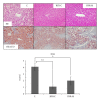Study of the effects of monacolin k and other constituents of red yeast rice on obesity, insulin-resistance, hyperlipidemia, and nonalcoholic steatohepatitis using a mouse model of metabolic syndrome
- PMID: 23320041
- PMCID: PMC3541547
- DOI: 10.1155/2012/892697
Study of the effects of monacolin k and other constituents of red yeast rice on obesity, insulin-resistance, hyperlipidemia, and nonalcoholic steatohepatitis using a mouse model of metabolic syndrome
Abstract
Purpose. Nonalcoholic fatty liver disease (NAFLD) is a progressive and intractable disease associated with metabolic syndrome. Red yeast rice (RYR) contains monacolin K, a potent inhibitor of HMG-CoA reductase, and its consumption decreases cholesterol and triglyceride levels. We examined the efficacy of RYR constituents using a novel metabolic syndrome-NAFLD mouse model (MSG mice). Methods. Two types of RYR grown under different culture conditions were used. 1P-DU contained only 0.002 g/100 g of monacolin K, whereas 3P-D1 contained 0.131 g/100 g. MSG mice were divided into three groups: control (C) group fed standard food, RYR-C group fed standard food with 1% 1P-DU, and RYR-M group fed standard food with 1% 3P-D1. Mice were examined from 12 to 24 weeks of age. Results. Serum insulin, leptin, and liver damage as well as macrophage aggregation in visceral fat in RYR-C and RYR-M groups were lower than those in C group. The serum adiponectin levels in RYR-C group were significantly higher than those in RYR-M and C groups. Conclusions. RYR was effective against obesity-related inflammation, insulin resistance, and NAFLD in MSG mice irrespective of monacolin K levels. GABA and various peptides produced during fermentation were determined as the active constituents of RYR.
Figures





Similar articles
-
A Randomized Clinical Efficacy Trial of Red Yeast Rice (Monascus pilosus) Against Hyperlipidemia.Am J Chin Med. 2019;47(2):323-335. doi: 10.1142/S0192415X19500150. Epub 2019 Mar 14. Am J Chin Med. 2019. PMID: 30871361 Clinical Trial.
-
Beneficial Effects of Red Yeast Rice on High-Fat Diet-Induced Obesity, Hyperlipidemia, and Fatty Liver in Mice.J Med Food. 2015 Oct;18(10):1095-102. doi: 10.1089/jmf.2014.3259. Epub 2015 Jul 1. J Med Food. 2015. PMID: 26133037
-
Red Yeast Rice (RYR) supplementation in patients treated with second-generation antipsychotics.Complement Ther Med. 2018 Apr;37:167-171. doi: 10.1016/j.ctim.2018.03.007. Epub 2018 Mar 15. Complement Ther Med. 2018. PMID: 29609929
-
Red Yeast Rice Plus Berberine: Practical Strategy for Promoting Vascular and Metabolic Health.Altern Ther Health Med. 2015;21 Suppl 2:40-5. Altern Ther Health Med. 2015. PMID: 26308759 Review.
-
Functional food red yeast rice (RYR) for metabolic syndrome amelioration: a review on pros and cons.World J Microbiol Biotechnol. 2016 May;32(5):87. doi: 10.1007/s11274-016-2035-2. Epub 2016 Apr 2. World J Microbiol Biotechnol. 2016. PMID: 27038957 Review.
Cited by
-
Effects of Monacolin K in Nondiabetic Patients with NAFLD: A Pilot Study.Nutrients. 2023 Apr 14;15(8):1887. doi: 10.3390/nu15081887. Nutrients. 2023. PMID: 37111106 Free PMC article.
-
Real-World Risk and Outcome of Liver Cirrhosis in Patients with Hyperlipidemia Treated with Red Yeast Rice: A Retrospective Cohort Study.J Multidiscip Healthc. 2024 Jul 30;17:3727-3738. doi: 10.2147/JMDH.S466696. eCollection 2024. J Multidiscip Healthc. 2024. PMID: 39100903 Free PMC article.
-
Nonalcoholic Fatty Liver Disease: Pathogenesis and Treatment in Traditional Chinese Medicine and Western Medicine.Evid Based Complement Alternat Med. 2020 Jan 4;2020:8749564. doi: 10.1155/2020/8749564. eCollection 2020. Evid Based Complement Alternat Med. 2020. PMID: 31998400 Free PMC article. Review.
-
Influence of diet supplementation with green tea extract on drug-metabolizing enzymes in a mouse model of monosodium glutamate-induced obesity.Eur J Nutr. 2016 Feb;55(1):361-71. doi: 10.1007/s00394-015-0856-7. Epub 2015 Feb 8. Eur J Nutr. 2016. PMID: 25663641
-
Decreased Risk of Stroke in People Using Red Yeast Rice Prescriptions (LipoCol Forte®): a Total Population-Based Retrospective Cohort Study.Evid Based Complement Alternat Med. 2022 Apr 23;2022:8160425. doi: 10.1155/2022/8160425. eCollection 2022. Evid Based Complement Alternat Med. 2022. PMID: 35502179 Free PMC article.
References
-
- Williams CD, Stengel J, Asike MI, et al. Prevalence of nonalcoholic fatty liver disease and nonalcoholic steatohepatitis among a largely middle-aged population utilizing ultrasound and liver biopsy: a prospective study. Gastroenterology. 2011;140(1):124–131. - PubMed
-
- Farrell GC, Larter CZ. Nonalcoholic fatty liver disease: from steatosis to cirrhosis. Hepatology. 2006;43(2, supplement 1):S99–S112. - PubMed
-
- Musso G, Gambino R, Cassader M, Pagano G. A meta-analysis of randomized trials for the treatment of nonalcoholic fatty liver disease. Hepatology. 2010;52(1):79–104. - PubMed
-
- Gastaldelli A, Harrison SA, Belfort-Aguilar R, et al. Importance of changes in adipose tissue insulin resistance to histological response during thiazolidinedione treatment of patients with nonalcoholic steatohepatitis. Hepatology. 2009;50(4):1087–1093. - PubMed
-
- Georgescu EF. Angiotensin receptor blockers in the treatment of NASH/NAFLD: could they be a first-class option? Advances in therapy. 2008;25(11):1141–1174. - PubMed
LinkOut - more resources
Full Text Sources
Other Literature Sources

